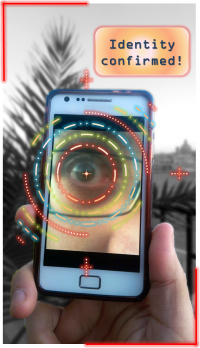Fernando/Biometria UIB

| |
| Reconocimiento Biométrico | |
|---|---|
| Contacto: Fernando Alonso-Fernandez |
Contents
- 1 Reconocimiento Biométrico / Biometrics Recognition
- 1.1 Contacto
- 1.2 Descripción
- 1.3 Contenido
- 1.4 Material
- 1.4.1 Clase 1: Basic definition, applications, sectors, market
- 1.4.2 Clase 2: Biometric systems, working modes, performance & errors
- 1.4.3 Clase 3: Limitations, unsolved problems, acceptance, design issues (pt1), Biometric modalities, algorithms, state of the art (pt2)
- 1.4.4 Clase 4: Attacks, template protection, the future...
- 1.5 Bibliografía y Recursos
Reconocimiento Biométrico / Biometrics Recognition
Página de Reconocimiento Biométrico
Parte del curso Interfaces Gráficos de Usuario, Grado en Ingeniería Informática, Universitat de les Illes Balears
Webpage of Biometrics Recognition
Part of the course Graphic User Interfaces, Degree in Computer Engineering, University of the Balearic Islands
 |

|
Contacto
Email: feralo(AT)hh.se.
Descripción
Este curso está basado en el curso "Biometric Recognition/Biometrisk Identifiering" del programa de grado en IT-Forensics de la Universidad de Halmstad (Suecia).
El curso original se imparte en inglés, por lo que el material está en inglés también y esta página mezcla ambos idiomas, dado que voy extrayendo el contenido del curso original. No obstante, las clases se impartirán/grabarán en castellano. Si el inglés supone algún problema, hacédmelo saber a mi o al responsable del curso de la UIB para buscar una solución.
¿Sabías que la UIB y la Universidad de Halmstad tienen un convenio firmado dentro del programa de intercambio Erasmus? Si estás interesado en estudiar durante un semestre en la Universidad de Halmstad y que los créditos que obtengas se te convaliden para el programa que estás estudiando en la UIB, contactanos a mi o al responsable del curso de la UIB para saber más detalles.
¿Sabías que en Suecia la educación no tiene tasas para ciudadanos de la UE? Si estás interesado en hacer un máster en el extranjero, en la Universidad de Halmstad tenemos varios programas en inglés. Contáctame si quieres saber más detalles.
Contenido
Durante las clases, se irán cubriendo los siguientes aspectos (cada apartado se corresponde aproximadamente con una clase):
- Basic definition, applications, sectors, market
- Biometric systems, working modes, performance & errors
- Limitations, unsolved problems, acceptance, design issues
- Biometric modalities, algorithms, state of the art
- Attacks, template protection, the future…
Material
Clase 1: Basic definition, applications, sectors, market
Content of the lecture is as follows.
In brackets, it is indicated its correspondence with the sections of articles 1-50_years_of_biometrics_research_Jain.pdf (numerals) and 2-Intro_to_Biometrics_Recogn_Jain.pdf (roman numbers):
- Biometrics
- Intro & Definitions (I, 1)
- Biological/behavioural traits (I, 1)
- Requirements of a biometric trait ( I, 1)
- How to choose a biometric trait (2.1)
- Application examples (V, 2.1)
- Sectors
- Market
- Mobile/ubiquitous biometrics
Clase 2: Biometric systems, working modes, performance & errors
Content of the lecture is as follows.
In brackets, it is indicated its correspondence with the sections of articles 1-50_years_of_biometrics_research_Jain.pdf (numerals) and 2-Intro_to_Biometrics_Recogn_Jain.pdf (roman numbers):
- Automatic biometric systems
- Structure/parts (II, 2)
- Working modes 1:1, 1:N, 1:N+1 (II, 2)
- Performance analysis & system errors (III)
Clase 3: Limitations, unsolved problems, acceptance, design issues (pt1), Biometric modalities, algorithms, state of the art (pt2)
Content of the lecture is as follows.
In the first part, we will address the limitations and other issues of biometric systems. In brackets, it is indicated its correspondence with the sections of articles 1-50_years_of_biometrics_research_Jain.pdf (numerals) and 2-Intro_to_Biometrics_Recogn_Jain.pdf (roman numbers):
- Limitations of biometrics, Social Acceptance, Design Considerations (VII, IX, 5)
In the second part, we will see a quick overview of the main biometric modalities (fingerprint, face, iris). In brackets, it is indicated its correspondence with the sections of articles 1-50_years_of_biometrics_research_Jain.pdf (numerals) and 2-Intro_to_Biometrics_Recogn_Jain.pdf (roman numbers):
- Overview of biometric modalities (IV, 3)
Clase 4: Attacks, template protection, the future...
Content of the lecture is as follows.
This lecture covers the topic of biometric attacks. This material is briefly covered in the article 1-50_years_of_biometrics_research_Jain.pdf (section 5.4).
Bibliografía y Recursos
La mayor parte del material (transparencias) se basa en los siguientes artículos, principalmente las referencias 1 y 2 que contienen una introducción general a la biometría.
Introducción general a la biometría:
1. A. K. Jain, Karthik Nandakumar, Arun Ross, "50 years of biometric research: Accomplishments, challenges, and opportunities", Pattern Recognition Letters, Volume 79, 2016 (pdf)
2. A. K. Jain, A. Ross and S. Prabhakar, "An introduction to biometric recognition," IEEE Transactions on Circuits and Systems for Video Technology, vol. 14, no. 1, pp. 4-20, Jan. 2004 (pdf)
Breve introducción a la evaluación de sistemas biométricos
3. P. J. Phillips, A. Martin, C. l. Wilson, M. Przybocki, " An Introduction to Evaluating Biometric Systems ", Computer, vol. 33, no. 2, pp. 56-63, Feb. 2000 (pdf)
Biometría forense:
4. A. K. Jain and A. Ross, "Bridging the Gap: From Biometrics to Forensics", Philosophical Transactions of The Royal Society B, Vol. 370, No. 1674, August 2015 (pdf)
Guía de buenas prácticas en investigación biométrica:
5. A. Jain, B. Klare and A. Ross, "Guidelines for best practices in biometrics research," 2015 International Conference on Biometrics (ICB), Phuket, 2015, pp. 541-545 (pdf)